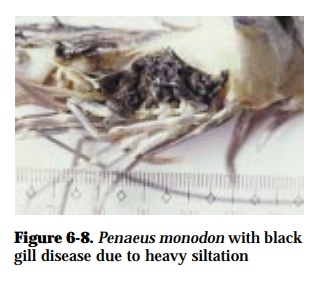Chapter: Health Management in Aquaculture: Environmental and other non-infectious diseases
Black Gill Disease - Shrimp Diseases
Black Gill Disease
Black gill disease is due to chemical contaminants, heavy siltation and ammo-nia or nitrite in rearing water; high organic load due to residual feed, debris, and fecal matter on pond bottom (i.e. black soil).
SIGNS:
The gills of affected shrimps show reddish, brownish to black discoloration and, in advanced cases, gill filaments become totally black (Fig. 6-8).

EFFECTS ON HOST:
Histological observations show that blackening of the gills may be due to the deposition of melanin at sites of tissue necrosis and heavy hemocyte activity.
PREVENTION AND CONTROL:
• Avoid heavy metal discharges of nearby factories from getting into the rear-ing facilities
• Remove black soil by scraping after each harvest and by draining pond wa-ter from the bottom during the culture period
Related Topics